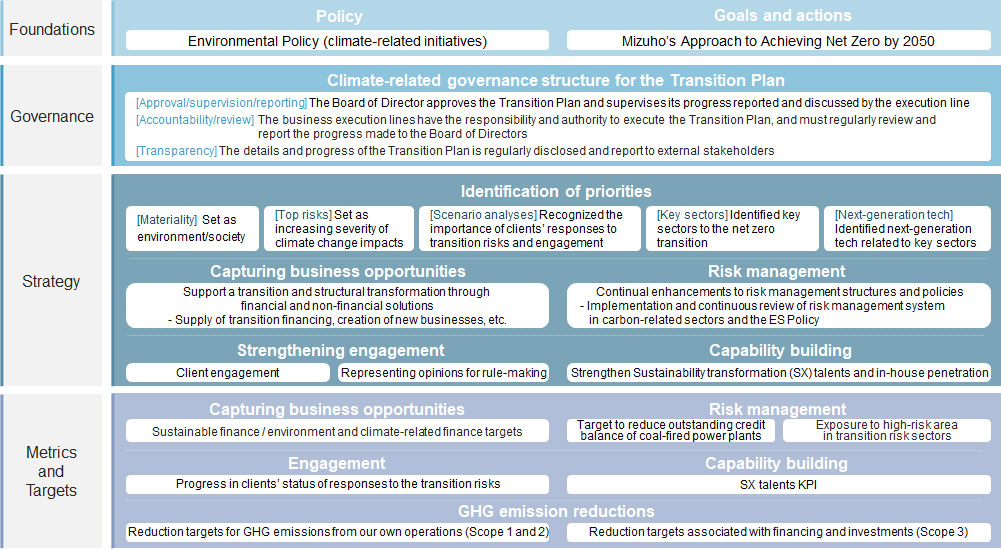Environmental Policies and Targets
Environmental Policy
Mizuho's Approach to Achieving Net Zero by 2050
Environmental Targets
ESG Data Book (Reduction of Environmental Impact) (PDF/1,179KB)
Net Zero Transition Plan
Mizuho's Net Zero Transition Plan (overview)

| Component | Description |
| Foundations | |
|---|---|
| Policy | This component clarifies the issue awareness and concrete actions that form the basis of environmental initiatives, including climate change actions, in the Environmental Policy, and defines our stance on climate change toward achieving a low-carbon society. |
| Aims and Actions | In order to make actual progress on the stance outlined above, this component clarifies our aims and actions to achieve a low-carbon society by 2050 and to pursue efforts to limit worldwide temperature increase to 1.5°C as described in Mizuho's Approach to Achieving Net Zero by 2050. |
| Governance | |
| Climate-related governance structure for the Transition Plan | Approval, supervision, and reporting: The Board of Directors approved the revised Net Zero Transition Plan (formulated in April 2022 and revised in April 2023). Regarding the Transition Plan's progress, the Board of Directors supervises information reported to it after discussions by the business execution line. |
| Accountability and review: The business execution line is accountable and responsible for the execution of the Transition Plan, conducts periodic reviews of the plan's execution status, and reports the review findings to the Board of Directors. | |
| Transparency: The Transition Plan and the status of related initiatives are regularly disclosed and reported to external stakeholders. | |
| Strategy | |
| Identification of priorities | Materiality: This component identifies environment and society as one materiality – a priority issue over the medium to long term for sustainable growth and development of Mizuho and its stakeholders, including clients, employees, and the economy and society. |
| Top risks: The component notes that Worsening impact of climate change has been set as one of the top risks for FY2024. | |
| Scenario Analyses: The component recognizes the importance of the engagement and corporate clients' responses to transition risks, based on considerations of the results of past scenario analyses. | |
| Key sectors: Based on emission volume (impact on the real economy), Mizuho's opportunities and risks associated with decarbonization and the characteristics of Mizuho's portfolio and client base, the component identifies key sectors to focus on from a decarbonization perspective. - Electric power, energy, steel, chemicals, automotive, maritime transportation, aviation, and real estate sectors |
|
| Next-generation technologies: The component identifies next-generation technologies associated with decarbonization in the key sectors given above. - Hydrogen, offshore wind farms, CCS1, and biomass (SAF2) |
|
| Capturing business opportunities | Support clients' transition to decarbonization and business structural transformation based on sustainable business strategy. - Steady transition support toward 2030 - Promote clients' future-oriented actions |
| Risk management | Continuous improvements to risk management systems and policies - Improvements to risk controls in carbon-related sectors through evaluations of clients' responses to transition risks - Operation of and continuous revisions of the Environmental and Social Management Policy for Financing and Investment Activity (ES Policy) |
| Strengthening engagement |
|
| The component describes initiatives to strengthen Mizuho's communications and its participation in international rule-making through study groups and bodies organized by government agencies and research institutes. | |
| Capability building | This component describes initiatives to enhance human resources in relation to sustainability transformation and strengthen two-way communications with employees on sustainability related topics. |
| Metrics and Targets | |
| (Position of metrics and targets) | This component sets the following metrics and targets to measure the progress of initiatives described in the Strategy section above and the contribution to transition of the real economy as a result of the initiatives. |
| Capturing business opportunities |
|
| Risk management |
|
| Engagement |
|
| Capability building |
|
| GHG emission reductions |
|
1 CCS:Carbon dioxide Capture and Storage
2 SAF:Sustainable Aviation Fuel
Third–Party Verification
Third party verification report
Education for our Executive Officers and Employees
Mizuho provides education, training, and information to ensure our executive officers and employees comply with all relevant regulations and processes. We also provide training programs, internal communication tools, and study sessions with related companies and departments to deepen understanding about environmental and human rights issues with the objective of promoting awareness throughout our organization so all executive officers and employees will conduct their duties conscientiously.